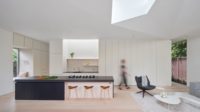Taking advantage of Los Angeles zoning that allows two single-family residences to sit on one parcel of real estate, 2017 Vanguard firm FreelandBuck designed Second House to take cues from the Culver City property’s original structure, while also completely departing from it. The angular 1,500-square-foot dwelling presents a study in how to shrewdly carve out living space on a stingy footprint.
The owners, a couple, asked for a small, low-maintenance house with outdoor areas and a generous master suite, says L.A.-based principal David Freeland. (He met New York–based principal Brennan Buck in graduate school at UCLA.) The clients also wanted the design to shield them from neighbors on either side as well as from the original house, which will be leased to tenants. That 1938 structure is set back from the street on its narrow lot, making a small site even smaller, and it features a hybrid roof design, with steep gables and complex pitched surfaces.
These conditions gave rise to Second House’s unusual form, a multifaceted two-level structure composed of three distinct volumes that fully express the indoor spaces and surround a central courtyard. The craggy exterior and its cladding of custom cement panels are a nod to the quirky, asphalt-shingled roof next door.
On the main level, entry alcoves on the west and east sides open into a kitchen/dining area and a snug living room, respectively. These rooms spill into the courtyard, a year-round gathering spot. Here, floors and finishes subtly define the alternating indoor and outdoor spaces in a cohesive open floor plan. In contrast, the second-floor master and guest bedrooms are entirely separate, each accessible by a dedicated stair.
High, sloped ceilings and variable ceiling heights make for an airy, dynamic interior, and operable windows on upper walls offer privacy but enable natural lighting, cross-ventilation, and oblique sight lines through the house and to the surrounding sky and rugged hills. These moves, and outdoor spaces that boost the usable floor area by a third, liberate Second House from the tight suburban fabric that hems it in on all sides. It lives like a much larger home—a feat enabled by its unexpected and clever design.








Post a comment to this article
Report Abusive Comment